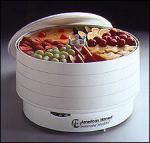Search engine visitors - click here to access entire "$ensible Home" web site
Click here to see a descriptive illustration showing several types of solar food dryers.
Dear Jim: I plan to buy a lot of fruits and vegetables now (lower prices) and preserve them for natural snacks and cooking. I thought about drying them. Do solar dryers work well or are electric ones best? - Pat K.

A: Drying is one of the best methods to preserve foods for snacks or for use in cooking. It is ideal for fruits and vegetables, and when done properly, very little nutritional value is lost. The savings by drying your own food in volume can be substantial, especially when using free solar energy.
Also, if you are trying to live and eat as naturally as possibly, building or buying a solar food dryer makes the most sense. It is a little less convenient than using an electric dryer (often called dehydrator), but solar dryers require no power other than the sun. Both types are equally effective.
There are solar dryer kits available (for about $50) that are simply a hanging, screened cage with a zipper and three durable screened shelves. They allow for plenty of air flow for rapid drying. In early spring, they are also effective to sprout vegetable or flower seedlings on solid trays.
More sophisticated solar dryer kits are made of durable, no-rust stainless steel, a rigid arched clear cover and adjustable side vents. These will dry the foods faster and provide more control over the temperature inside.
Some simple, yet effective, electric food dryers start at $40. These have five trays, one above another, and the drying temperature varies depending on which level the tray is placed. These are a vertical air flow design. They use up to 300 watts of electricity for the heater and small fan.
More expensive models, with thermostats, use a more effective horizontal air flow. With horizontal air flow, many drying trays can be stacked. The horizontal air flow maintains even drying temperatures across all the trays and there is less mixing of flavors if you are drying different foods.
If you are handy with tools and have $50 to invest, consider building a solar-powered food dryer. The design concept is a plywood box with a clear top over a solar collector (heating plate). The purpose of the collector is to create even heating and to shield the food from the direct sun rays.
The plywood box should have screened openings at the bottom and top. The solar heat creates the natural air flow through the dryer. An old storm window works well for the clear top. Use any sheet metal, flashing, etc. painted black beneath it. Tilt it up toward the sun on adjustable legs.
You can vary the temperature inside the dryer by adjusting the legs to change the tilt and by installing small additional adjustable side vents.
Instant Download Update Bulletin No. 792 - buyer's guide of electric food dryers and dehydrators showing wattage, warranty and features, recommended features to look for when selecting a food dehydrator, recommended tips for solar drying fruits, recommendations for solar drying vegetables, suggestions for successful drying in a solar food dryer and do-it-yourself instructions for a solar food dryer, materials required, illlustrations and dimensions.
Dear Jim: We have an above-ground swimming pool that I want to put some fish in and use as a pond. We still plan to swim in it once in a while like in a lake. I don't want to use any chemicals, so how can I aerate it? - Carol G.
A: There are many ways to aerate water for fish with air pumps and bubblers. There are also solar-powered devices that can generate ions to control algae growth.
Your idea of still swimming in it is not good. Pool water must be treated with chemicals, ozone and/or strong ion generators to make it safe for humans. Check with your local health department for the treatments required.